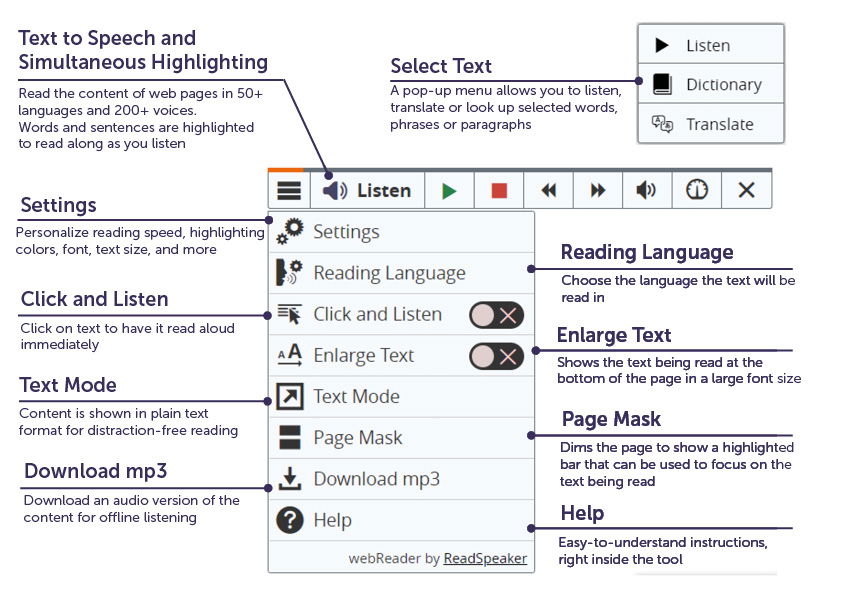
Nearly every teacher has encountered this scenario: A child comes to school unable to read. He has difficulty recognizing letters and has trouble with the sounds each letter makes. He has little to no sight word vocabulary and has limited interest in books or stories.
The student’s parents and teachers spend extra time and use motivational techniques to encourage him to read. However, he still does not develop the reading skills he needs to be able to gain meaning from text with the speed, fluency and comprehension he needs. In Grade 5, he is only able to read at a Grade 1 level. It’s all too common—and pandemic disruptions only made the challenge greater.
What can families and educators do to help these struggling readers? Here’s a round-up of reading education solutions, starting with an introduction to read-along text-to-speech (TTS) tools.
Looking for digital accessibility tools to support struggling readers?
Contact ReadSpeaker
| Table of Contents
1. Read-Along Technology with TTS 2. TTS Assisted Reading Tools in the Classroom |
Read-Along Technology with TTS
Traditionally, reading strategies develop the ability to decode and make the connection between sounds and letters. However, these methods are not effective for some students who have difficulty with information processing. Decoding can take an enormous amount of effort for these readers. By the time the word is successfully decoded, the child may no longer have the energy to understand or use the content.
Many of these students become frustrated, entering a cycle of withdrawal from text and ceasing to read. This in turn causes them to lose contact with text of all sorts, undermining their reading development and the acquisition of knowledge and understanding in all subjects.
Assistive technology—specifically text to speech (TTS)—offers these students hope. A TTS tool like ReadSpeaker’s TextAid reads text aloud as it highlights the relevant content. ReadSpeaker’s webReader does the same for online text, while adding accessibility tools like text enlargement, page masks, and personalized settings. This sort of read-along technology empowers struggling readers to work autonomously at grade-level, giving them the chance to put aside decoding difficulties and move on to high-level thinking.

With TTS read-along solutions, struggling readers are no longer stuck on the basics of decoding and understanding text; they are given new and exciting opportunities to engage with the content, to make meaning from text, and to develop comprehension and study skills. This underlines the need to not only continue to teach students who struggle to read to decode, but to give them opportunities to interact with content and the written word in other ways.
Research tells us that children who fall behind in reading subsequently read less, which in turn causes a growing gap in skills between struggling readers and their peers. This undermines the crucial self-belief that is necessary to cultivate strong reading skills, which lead to strong lifetime study skills. Choice has also been shown to be a key motivator in encouraging readers—allowing students to choose what, when, and how to read.
Michelann Parr is a professor at the Schulich School of Education at Canada’s Nipissing University. Parr specializes in language, literacy, and special education, and says that it’s crucial for student reading to go beyond decoding.
“Struggling readers should not be limited to low-level activities focused on decoding and literal comprehension.” — Michelan Parr, Professor of Education, Nipissing University
Text-to-speech audio tools help readers successfully decode text in order to gain higher-level comprehension, when and how they choose. That could be at home or in the classroom.
TTS-Assisted Reading Tools in the Classroom
How can teachers use TTS read-along tools for classroom reading instruction—or for teaching subjects beyond reading?
While a confident reader may find TTS to be more distracting than helpful, it enhances comprehension for average readers, while freeing struggling readers from low-level decoding tasks. Read-along, speech-enabled tools help these learners access texts that allow for higher-level thinking. That also builds confidence during interactions with texts—and other students.
In the classroom, the key is to make read-along assistive technology available. Teachers must also give students the choice to use these tools, in accordance with Universal Design for Learning. Crucially, teachers must offer this choice without inducing feelings of stigmatization or privilege; present audio read-along solutions as just another educational tool among many.
While teachers and parents may analyze the strengths, needs, and environment of a student, the use of text to speech should be decided on by the students themselves, just as they may (sometimes) choose what and when to read. When the student is allowed to decide, the technology supports choice, independence, and self-esteem.
In addition, by adding TTS to your range of literacy tools, you emphasize the importance of comprehension and lifelong thinking skills over word and decoding knowledge.
In short, TTS in the classroom enables students to participate as and when they wish in the conversation going on around them. But assisted reading tools are helpful outside the classroom, too—and TTS is just one of the online resources that can help students succeed.
Online Resources for Struggling Readers and Their Families
Parents and educators who work with struggling readers are faced with many challenges: helping students stay at grade level, improving motivation, dealing with feelings of isolation and even bullying. However, there is a growing pool of resources to help families support struggling readers. Here are just a few reading assistance websites that are worth a look:
- Reading Rockets’ section on learning disabilities. The Reading Rockets project is guided by an advisory panel made up of leading researchers and experts in the field of reading and includes PBS television programs, online services, professional development opportunities, and a social community.
- Reading Rockets’ sister site, LD OnLine, is a leading website on learning disabilities for parents and educators.
- Understood.org is also an excellent nonprofit resource for learning and attention issues. We recommend accessing the myriad of articles the site has on subjects from what every parent needs to know about reading to text to speech, what it is, and how it works.
- The Institute of Reading Development offers six-week online programs to support readers wherever they are in their development. Age- and ability-appropriate reading materials help students develop reading skills, while group activities and discussions go beyond the page to instill a lifelong love of reading.
It is also important to seek out inspiration, and the internet is a perfect place to do so. Students as well as parents will be encouraged when they see they are not alone with their learning issues.
Take this video about Ben, a determined boy with dyslexia and a wonderful story.
Ben’s use of audio to read the Harry Potter series just goes to show how powerful bimodal learning can be for struggling readers. Whether looking for resources, information, or support, parents are encouraged to research online and reach out to the organizations that seem to be the best fit for both a child’s issues and the family’s own philosophy.
Offline Assistance for Struggling Readers
While there’s plenty of online support for those dealing with struggling readers, sometimes you just want some hands-on, face-to-face time. That wasn’t available as COVID-19 raged, but as we publish, these options are coming back—and not a moment too soon.
There’s no substitute for meeting up with other professionals and families who are dealing with similar issues. Whether you do it in a learning center or a coffee shop, sharing ideas and inspiration is an important tool for finding what works for each individual reader. The following are some good places to find off-line support:
Parent Centers

Parent Centers are sponsored by the U.S. federal government. They provide workshops and training, and give advice about dealing with learning disabilities at home. These centers have libraries, lists of specialists, opportunities to try out assistive technology, and more. The staff is trained to give you help, advise, and point you in the right direction. Every state has its own title for its Parent Centers—which can make navigating the system a bit confusing—but you can find the one closest to you here.
The National Literacy Directory

In-person reading programs operate locally, of course. Use the National Literacy Directory to find reading assistance programs in your area that cover early childhood, family literacy, adult education, language learning, and more.
Private Tutors

Reading tutors can help in many ways, assisting with social as well as academic issues. You will find a wealth of articles and information on how to find and work with a tutor on Understood.org. Living with learning disabilities, learning a second language, and low literacy are all challenges—so take the time to develop a strong support network around you as you find what works for your family.
As these resources suggest, read-along technology with TTS is just one of the tools available to help struggling readers, whether you’re a teacher, a parent, or a student yourself. At the same time, assistive technology like TTS is a powerful way to support students who aren’t reading at grade level.
Failing to reach your struggling readers? Text to speech can help.
Contact us
AI enthusiast and web developer at ReadSpeaker since 2014, I combine technical expertise with data analysis to drive innovation. Passionate about exploring new technologies, I’m motivated by complex challenges and always curious to push the limits of what’s possible.


